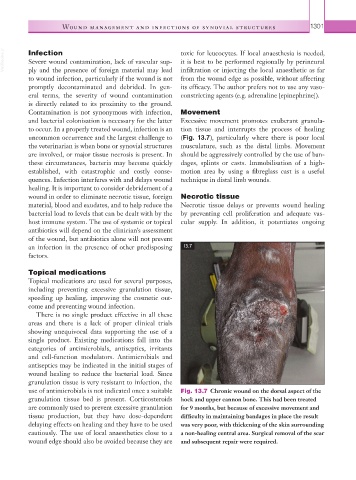Page 1326 - Equine Clinical Medicine, Surgery and Reproduction, 2nd Edition
P. 1326
Wound management and infections of synovial structures 1301
VetBooks.ir Infection toxic for leucocytes. If local anaesthesia is needed,
it is best to be performed regionally by perineural
Severe wound contamination, lack of vascular sup-
ply and the presence of foreign material may lead
from the wound edge as possible, without affecting
to wound infection, particularly if the wound is not infiltration or injecting the local anaesthetic as far
promptly decontaminated and debrided. In gen- its efficacy. The author prefers not to use any vaso-
eral terms, the severity of wound contamination constricting agents (e.g. adrenaline [epinephrine]).
is directly related to its proximity to the ground.
Contamination is not synonymous with infection, Movement
and bacterial colonisation is necessary for the latter Excessive movement promotes exuberant granula-
to occur. In a properly treated wound, infection is an tion tissue and interrupts the process of healing
uncommon occurrence and the largest challenge to (Fig. 13.7), particularly where there is poor local
the veterinarian is when bone or synovial structures musculature, such as the distal limbs. Movement
are involved, or major tissue necrosis is present. In should be aggressively controlled by the use of ban-
these circumstances, bacteria may become quickly dages, splints or casts. Immobilisation of a high-
established, with catastrophic and costly conse- motion area by using a fibreglass cast is a useful
quences. Infection interferes with and delays wound technique in distal limb wounds.
healing. It is important to consider debridement of a
wound in order to eliminate necrotic tissue, foreign Necrotic tissue
material, blood and exudates, and to help reduce the Necrotic tissue delays or prevents wound healing
bacterial load to levels that can be dealt with by the by preventing cell proliferation and adequate vas-
host immune system. The use of systemic or topical cular supply. In addition, it potentiates ongoing
antibiotics will depend on the clinician’s assessment
of the wound, but antibiotics alone will not prevent
an infection in the presence of other predisposing 13.7
factors.
Topical medications
Topical medications are used for several purposes,
including preventing excessive granulation tissue,
speeding up healing, improving the cosmetic out-
come and preventing wound infection.
There is no single product effective in all these
areas and there is a lack of proper clinical trials
showing unequivocal data supporting the use of a
single product. Existing medications fall into the
categories of antimicrobials, antiseptics, irritants
and cell-function modulators. Antimicrobials and
antiseptics may be indicated in the initial stages of
wound healing to reduce the bacterial load. Since
granulation tissue is very resistant to infection, the
use of antimicrobials is not indicated once a suitable Fig. 13.7 Chronic wound on the dorsal aspect of the
granulation tissue bed is present. Corticosteroids hock and upper cannon bone. This had been treated
are commonly used to prevent excessive granulation for 9 months, but because of excessive movement and
tissue production, but they have dose-dependent difficulty in maintaining bandages in place the result
delaying effects on healing and they have to be used was very poor, with thickening of the skin surrounding
cautiously. The use of local anaesthetics close to a a non-healing central area. Surgical removal of the scar
wound edge should also be avoided because they are and subsequent repair were required.

